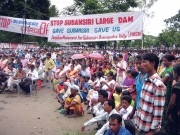Nagaland
Soil health management under hill agroecosystem of North East India - A paper from the journal Applied and Environmental Soil Science
Posted on 19 May, 2012 03:33 PMThe paper published in the journal Applied and Environmental Soil Science discusses the need for a viable option for ecorestoration and maintenance of soil resources to sustain long-term soil productivity and improve food security for the region.
eNorth East 2011 summit & awards, North East Development foundation, November 25, 2011, Kohima, Nagaland
Posted on 23 Nov, 2011 08:18 AMOrganizers: North East Development foundation and Digital Empowerment Foundation (DEF)
Venue: Regional Institute of e-Learning & Information Technology (RIELIT), Kohima, Nagaland
Demonstration cum dissemination of the feasibility of KAF (Kanchan Arsenic Filter) in Assam - A workshop report - IGSSS and Welthungerhilfe (26th July 2011)
Posted on 21 Nov, 2011 10:26 AMThe workshop aimed at possible replication and acceptability of KAF as a viable, low cost appropriate arsenic mitigation measure in the arsenic contaminated regions of the country.
Living rivers, dying rivers: Rivers in North East India
Posted on 15 Nov, 2011 03:29 PMRivers in North-East India

Damming North East India - Juggernaut of hydropower projects threatens social and environmental security of region
Posted on 28 Dec, 2010 07:49 PM This report by Kalpavriksh, Aaranyak and ActionAid India deals with the large dams’ juggernaut, which happens to be the biggest ‘development’ intervention in this ecologically and geologically fragile, seismically active and culturally sensitive region in the coming days. With the Northeast identified as India’s ‘future powerhouse’ and at least 168 large hydroelectric projects set to majorly alter the riverscape, large dams are emerging as a major issue of conflict in the region.
This report by Kalpavriksh, Aaranyak and ActionAid India deals with the large dams’ juggernaut, which happens to be the biggest ‘development’ intervention in this ecologically and geologically fragile, seismically active and culturally sensitive region in the coming days. With the Northeast identified as India’s ‘future powerhouse’ and at least 168 large hydroelectric projects set to majorly alter the riverscape, large dams are emerging as a major issue of conflict in the region.
Although the current scale of dam-related developments far outstrips anything which took place in the past, the region has been no stranger to dam-related conflicts. For example, the Kaptai dam, built in the Chittagong Hill Tracts of East Pakistan (now Bangladesh) in the 1960s, submerged the traditional homelands of the Hajong and Chakma indigenous communities, and forced them to migrate into parts of Northeast India.
Rainwater harvesting in India: Traditional and contemporary
Posted on 21 Aug, 2009 12:41 PMThe document informs that traditionally Indians worshipped both water and rain as “Jala” and “Varuna”. Even rivers were worshipped. Till 3000 B.C., RWH happened without human effort as rain got collected in rivers and natural depressions. Civilizations flourished on river banks all over the world Indus valley civilization in India.
Impact of climate change in India: An agro - ecological zone level analysis
Posted on 20 Aug, 2009 06:04 PMIndia is gifted with heterogeneous landforms and variety of climatic conditions such as the lofty mountains, the raverine deltas, high altitude forests, peninsular plateaus, variety of geological formations endowed with temperature varying from arctic cold to equatorial hot, and rainfall from extreme aridity with a few cms (<10 cm) to pre humid with world's maxim
District human development report card for 10 districts- the PAHELI report
Posted on 01 Jun, 2009 03:46 PMThe PAHELI report (Peoples' Audit of Health Education and Livelihoods) is a rapid assessment of the prevailing status of human development in a district and covers four major sectors: life and livelihoods, water and sanitation, mother and child health, and education and literacy. The design and execution of PAHELI was done by Pratham and PAHELI district partners.
Understanding processes of watershed development program in India: report of a study anchored by WASSAN and facilitated by ICEF
Posted on 12 May, 2009 12:48 PMThis process study conducted by WASSAN with the support of ICEF is an attempt to bring focus on the processes of the watershed development projects. It is an attempt to provide feedback to the policy makers, donors and field level facilitators on the processes at the field level. It is an attempt to assess, diagnose and compare process at field level in different projects.